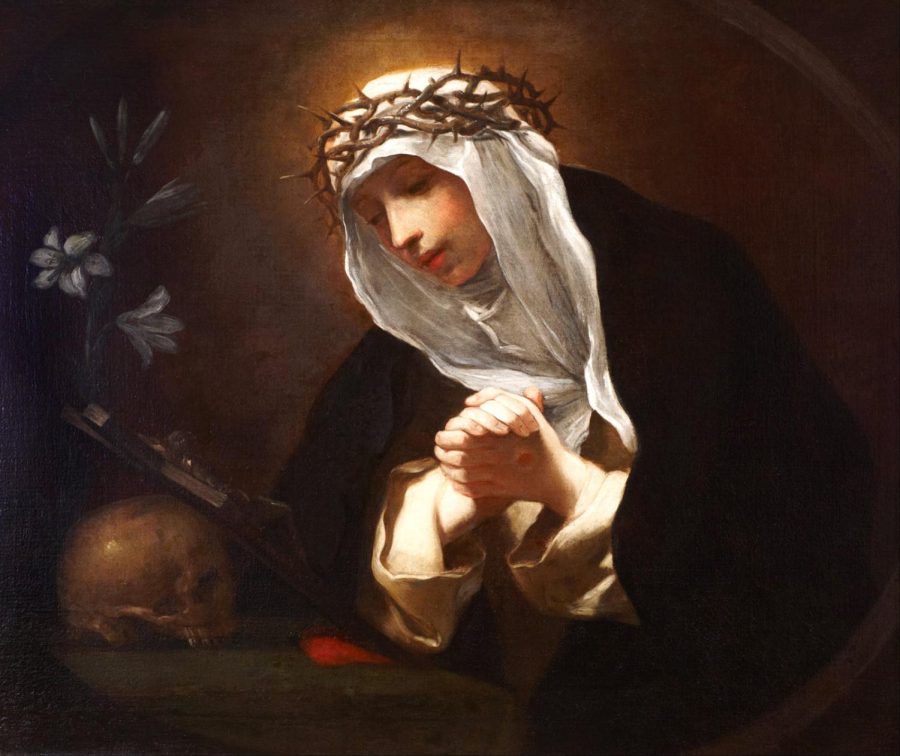Saint Features: Saint Catherine of Siena
Saint Catherine of Siena, a glorius saint and doctor of the church dedicated to love and passion of God’s will.
As Catholics, our chief ambition in life is not to become a famous singer or a celebrity, not to pursue a dream vacation, or to settle for anything less than spending eternity in Heaven with God. Everyone in heaven is a saint, so our main goal in life is to be a saint, whether we are canonized or not. According to the Oxford dictionary, a canonized saint is, “a person acknowledged as holy or virtuous and typically regarded as being in heaven after death.” To become a canonized saint, you have to pass five steps: death, servant of God, venerable, blessed, and finally, a canonized saint.
During my trip to Italy this past summer, I was privileged to discover many holy places, including the Vatican, several basilicas, and many popes’ and saints’ tombs including the tomb of St. Peter. My trip gave me inspiration to research and discover more saints that could serve as role models regarding how to live a life of holiness and virtue on earth. One saint that caught my attention was St. Catherine of Siena.
Catherine was born on March 25, 1347; the youngest of a humongous family of 24 brothers and sisters. In her time period, there was resentment for Pope Gregory XI on account of him leaving his hometown of Rome, and transferring to France. The deathly Bubonic Plague and the battle between England and France in the 100 Years War were also causing turmoil. At a young age, Catherine had a deep love and devotion to Jesus. Unlike most children, she enjoyed partaking in mass and often found quiet places where she could pray. At age six, she received her first vision where Jesus reached out and blessed her. This made her even more dedicated and determined to make an impact on the world that was full of hatred, disease, and war. At age twelve, when tempted to find a husband, in great adoration to Jesus, Catherine chopped off her hair to make herself less attractive. Six years later, Catherine joined the Third Order Dominicans. She had another vision at nineteen years old in which she saw Jesus putting a ring on her finger, symbolizing her great love and loyalty to Jesus. This is called spiritual marriage; to marry your soul to the eternal love of God. Furthering her Faith, during a visit to the city of Pisa, Catherine received the stigmata (the appearance of bodily wounds corresponding to the crucifixion wounds of Jesus typically received by members of religious orders) in the Church of Santa Cristina. Five red rays shot out of the crucifix, piercing her hands, feet, and heart while she was praying.
Besides Catherine’s devotion and visions, she also cared for the sick at the hospital of Santa Maria della Scala. When the Bubonic Plague hit, most people were anxious and fled, but Catherine, along with her followers, stayed to aid the sick and bury the dead. Furthermore, Catherine wrote countless letters to Pope Gregory XI stating that he should come back to Rome. In 1377, Catherine visited him and finally convinced him to come back. Lastly, she would talk to people about Catholicism and caused many to convert due to her wonderful words and love for her faith.
In 1380, at just 33, Catherine died while in Rome after suffering a stroke. She was buried at a cemetary near Santa Maria sopra Minerva in Rome. Raymond of Capua, a leading member of the Dominican Order and Catherine’s spiritual advisor, secretly decided to attempt to send part of Cathrine’s body back to Siena when her tomb was moved inside the Basilica of Santa Maria sopra Minerva in 1383 because that is what the people of her hometown wanted. He arranged for her head to be removed and brought to Siena. The thieves were stopped by guards as they tried to escape Rome, so they prayed to Catherine for help. When the guards checked the thieves bag, a miracle took place and all they saw was rose petals. When the head was finally delivered to Siena, the rose petals changed back to Catherine’s head. The mummified head continues to be displayed in the basilica of San Domenico in Siena. 1461 Pope Pius II proclaimed her a saint and in 1866 Pius IX embraced her as one of the patron saints of Rome. In 1939, along with St. Francis of Assisi, St. Catherine of Siena was proclaimed a patron saint of Italy by Pope Pius XII. She is also one of the four women who were named a doctor of the church.
By Ella Cronin ’28, Contributing Writer
28ecronin@montroseschool.org












